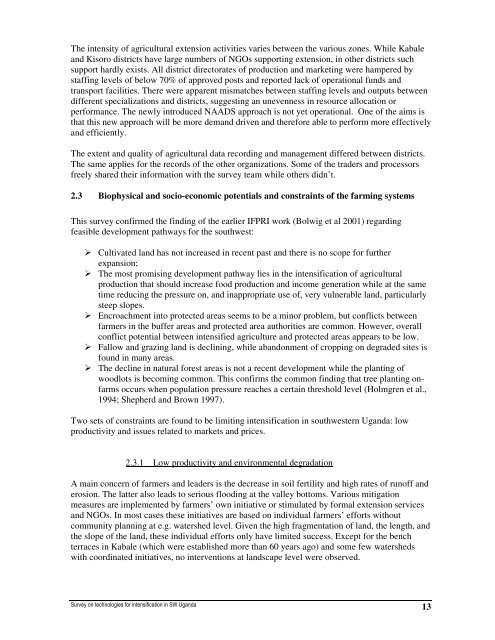Technologies for intensification in SW Uganda ... - Foodnet - cgiar
Technologies for intensification in SW Uganda ... - Foodnet - cgiar
Technologies for intensification in SW Uganda ... - Foodnet - cgiar
You also want an ePaper? Increase the reach of your titles
YUMPU automatically turns print PDFs into web optimized ePapers that Google loves.
The <strong>in</strong>tensity of agricultural extension activities varies between the various zones. While Kabale<br />
and Kisoro districts have large numbers of NGOs support<strong>in</strong>g extension, <strong>in</strong> other districts such<br />
support hardly exists. All district directorates of production and market<strong>in</strong>g were hampered by<br />
staff<strong>in</strong>g levels of below 70% of approved posts and reported lack of operational funds and<br />
transport facilities. There were apparent mismatches between staff<strong>in</strong>g levels and outputs between<br />
different specializations and districts, suggest<strong>in</strong>g an unevenness <strong>in</strong> resource allocation or<br />
per<strong>for</strong>mance. The newly <strong>in</strong>troduced NAADS approach is not yet operational. One of the aims is<br />
that this new approach will be more demand driven and there<strong>for</strong>e able to per<strong>for</strong>m more effectively<br />
and efficiently.<br />
The extent and quality of agricultural data record<strong>in</strong>g and management differed between districts.<br />
The same applies <strong>for</strong> the records of the other organizations. Some of the traders and processors<br />
freely shared their <strong>in</strong><strong>for</strong>mation with the survey team while others didn’t.<br />
2.3 Biophysical and socio-economic potentials and constra<strong>in</strong>ts of the farm<strong>in</strong>g systems<br />
This survey confirmed the f<strong>in</strong>d<strong>in</strong>g of the earlier IFPRI work (Bolwig et al 2001) regard<strong>in</strong>g<br />
feasible development pathways <strong>for</strong> the southwest:<br />
Cultivated land has not <strong>in</strong>creased <strong>in</strong> recent past and there is no scope <strong>for</strong> further<br />
expansion;<br />
The most promis<strong>in</strong>g development pathway lies <strong>in</strong> the <strong><strong>in</strong>tensification</strong> of agricultural<br />
production that should <strong>in</strong>crease food production and <strong>in</strong>come generation while at the same<br />
time reduc<strong>in</strong>g the pressure on, and <strong>in</strong>appropriate use of, very vulnerable land, particularly<br />
steep slopes.<br />
Encroachment <strong>in</strong>to protected areas seems to be a m<strong>in</strong>or problem, but conflicts between<br />
farmers <strong>in</strong> the buffer areas and protected area authorities are common. However, overall<br />
conflict potential between <strong>in</strong>tensified agriculture and protected areas appears to be low.<br />
Fallow and graz<strong>in</strong>g land is decl<strong>in</strong><strong>in</strong>g, while abandonment of cropp<strong>in</strong>g on degraded sites is<br />
found <strong>in</strong> many areas.<br />
The decl<strong>in</strong>e <strong>in</strong> natural <strong>for</strong>est areas is not a recent development while the plant<strong>in</strong>g of<br />
woodlots is becom<strong>in</strong>g common. This confirms the common f<strong>in</strong>d<strong>in</strong>g that tree plant<strong>in</strong>g onfarms<br />
occurs when population pressure reaches a certa<strong>in</strong> threshold level (Holmgren et al.,<br />
1994; Shepherd and Brown 1997).<br />
Two sets of constra<strong>in</strong>ts are found to be limit<strong>in</strong>g <strong><strong>in</strong>tensification</strong> <strong>in</strong> southwestern <strong>Uganda</strong>: low<br />
productivity and issues related to markets and prices.<br />
2.3.1 Low productivity and environmental degradation<br />
A ma<strong>in</strong> concern of farmers and leaders is the decrease <strong>in</strong> soil fertility and high rates of runoff and<br />
erosion. The latter also leads to serious flood<strong>in</strong>g at the valley bottoms. Various mitigation<br />
measures are implemented by farmers’ own <strong>in</strong>itiative or stimulated by <strong>for</strong>mal extension services<br />
and NGOs. In most cases these <strong>in</strong>itiatives are based on <strong>in</strong>dividual farmers’ ef<strong>for</strong>ts without<br />
community plann<strong>in</strong>g at e.g. watershed level. Given the high fragmentation of land, the length, and<br />
the slope of the land, these <strong>in</strong>dividual ef<strong>for</strong>ts only have limited success. Except <strong>for</strong> the bench<br />
terraces <strong>in</strong> Kabale (which were established more than 60 years ago) and some few watersheds<br />
with coord<strong>in</strong>ated <strong>in</strong>itiatives, no <strong>in</strong>terventions at landscape level were observed.<br />
13
















